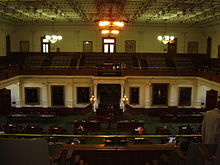Texas State Senator
| Texas State Senate | |
|---|---|
| Texas State Legislature | |
 |
|
| Type | |
| Type |
Upper house of the Texas Legislature
|
|
Term limits
|
None |
| History | |
|
New session started
|
January 10, 2017 |
| Leadership | |
|
President of the Senate
|
|
|
President Pro Tempore
|
|
| Structure | |
| Seats | 31 |
|
Political groups
|
Majority
Minority
|
 |
|
|
Length of term
|
4 years |
| Authority | Article 3, Texas Constitution |
| Salary | $7,200/year + per diem |
| Elections | |
| First-past-the-post | |
|
Last election
|
November 8, 2016 (16 seats) |
|
Next election
|
November 6, 2018 (15 seats) |
| Redistricting | Legislative Control |
| Meeting place | |
 |
|
| State Senate Chamber Texas State Capitol Austin, Texas |
|
| Website | |
| Texas State Senate | |
Majority
Minority
The Texas Senate is the upper house of the Texas State Legislature. There are 31 members of the Senate, representing single-member districts across the U.S. state of Texas, with populations of approximately 806,000 per constituency, based on the 2010 U.S. Census. There are no term limits, and each term is four years long. Elections are held in even numbered years on the first Tuesday after the first Monday in November. In elections ending in years ending in 2, all seats are up for election. Half of the senators will serve a two-year term, based on a drawing; the other half will fill regular four-year terms. As such, in other elections, about half of the Texas Senate is on the ballot. The Senate meets at the Texas State Capitol in Austin. The Republicans currently control the chamber, which is made up of 20 Republicans and 11 Democrats, as of January 10, 2017.
The Lieutenant Governor of Texas serves as the President of the Senate. Unlike most lieutenant governors who are constitutionally designated as presiding officers of the upper house, the Lieutenant Governor regularly exercises this function. The Lieutenant Governor's duties include appointing chairs of committees, committee members, assigning and referring bills to specific committees, recognizing members during debate, and making procedural rulings. The Lieutenant Governor may also cast a vote should a Senate floor vote end in a tie. If the Senate votes to dissolve itself into the Committee of the Whole, in which all members are part of the Committee, the President Pro-Tempore presides over the proceedings, with the Lieutenant Governor acting as a regular voting member. Due to the various powers of committee selection and bill assignment, the Lieutenant Governor is considered one of the most powerful lieutenant governorships in the United States.
Unlike other state legislatures, the Texas Senate does not include majority or minority leaders. Instead, the President Pro Tempore is considered the second most powerful position, and can be reserved to any political party in the chamber regardless if the party is a majority or not. Presidents Pro Tempore are usually the most senior members of the Senate. The President Pro Tempore presides when the Lieutenant Governor is not present or when the legislature is not in regular session.
...
Wikipedia
